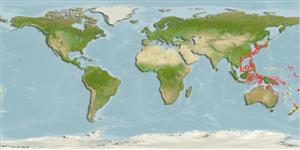Environment: milieu / climate zone / depth range / distribution range
Écologie
marin démersal; profondeur 110 - 152 m (Ref. 41422). Tropical
West Pacific: southern Japan to Hong Kong, Also from Australia, Taiwan, China and Korea. A new record for Indonesia (Ref. 5978).
Taille / Poids / Âge
Maturity: Lm ? range ? - ? cm
Max length : 22.0 cm SL mâle / non sexé; (Ref. 48635)
Épines dorsales (Total) : 8; Rayons mous dorsaux (Total) : 10; Épines anales: 3; Rayons mous anaux: 8; Vertèbres: 24. Parietal crests in males broad and short, not greatly elongated when compared with E. falcata. Dorsal fin rays 9.5-10.5; anal 7.5 (Ref. 41422). Adults develop a curious bony protrusion on top of the head (Ref. 48635).
Found in the sublittoral zone (Ref. 11230). Also seen in areas of cool upwelling on fine sand and mud bottoms (Ref 90102).
Life cycle and mating behavior
Maturities | Reproduction | Spawnings | Egg(s) | Fecundities | Larves
Masuda, H., K. Amaoka, C. Araga, T. Uyeno and T. Yoshino, 1984. The fishes of the Japanese Archipelago. Vol. 1. Tokai University Press, Tokyo, Japan. 437 p. (text). (Ref. 559)
Statut dans la liste rouge de l'IUCN (Ref. 130435)
Menace pour l'homme
Harmless
Utilisations par l'homme
Outils
Articles particuliers
Télécharger en XML
Sources Internet
Estimates based on models
Preferred temperature (Ref.
123201): 14.5 - 23.7, mean 19.6 °C (based on 61 cells).
Phylogenetic diversity index (Ref.
82804): PD
50 = 0.6250 [Uniqueness, from 0.5 = low to 2.0 = high].
Bayesian length-weight: a=0.01023 (0.00444 - 0.02358), b=3.01 (2.82 - 3.20), in cm total length, based on LWR estimates for this (Sub)family-body shape (Ref.
93245).
Niveau trophique (Ref.
69278): 4.0 ±0.7 se; based on size and trophs of closest relatives
Résilience (Ref.
120179): Milieu, temps minimum de doublement de population : 1,4 à 4,4 années (Preliminary K or Fecundity.).
Fishing Vulnerability (Ref.
59153): Low vulnerability (17 of 100).
